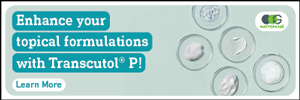Injection Devices
Vectura Expands Dry Powder Inhaler Development & Manufacturing Capabilities
Vectura Group plc, an industry leading inhalation CDMO, recently announced an expansion of its dry powder inhaler (DPI) development and manufacturing capabilities at its facility in Chippenham, UK…..
WuXi AppTec Completes Acquisition of OXGENE to Further Strengthen Cell & Gene Therapy Service Offerings for Global Customers
WuXi AppTec recently announced that it has completed the acquisition of OXGENE, a pioneering UK-based contract research and development organization that designs and develops scalable gene….
PRODUCT DEVELOPMENT STRATEGY - ESCP, Estimating Product Performance Part 1 - Playground Physics
Josef Bossart, PhD, introduces, in a series of short articles, a qualitative model to help understand and visualize the potential of a product with prescribers, patients, and payors. This simple model can help weed out product ideas that may at first glance seem attractive but offer little potential in the real world.
Progenity Initiates Safety & Tolerability Study of its Smart Capsule-Based Oral Drug Delivery System for GI Diseases
Progenity, Inc. recently announced the initiation of a clinical study for their Drug Delivery System (DDS) capsule, an ingestible and self-guided drug delivery device. The…
Stevanato Group Leads First Industry Discussion Paper on Primary Container Traceability
With years of experience in unit-level traceability of containers, Stevanato Group has been the lead in drafting this document. Having a standard for the unique…
Noble Launches Human Factors Engineering Services to Support Product Development and US FDA Approval of Medical Devices & Combination Products
Noble, an Aptar Pharma company and world leader in providing drug delivery training device programs for pharmaceutical companies and original equipment manufacturers, recently announced the launch of Human Factors Plus (HF+), an expanded service to further….
Gerresheimer Has Optimized the Test Cartridge & Reagent Block for Ergonomic Handling & Plastic-Suitable Production
Medical technology specialist Gerresheimer has developed the test cartridge and reagent block for a fully automatic blood analyzer that can be used to identify a…
Patent on Improved Particle Size Testing Method Granted to Hovione Will Impact Market
Grants for a patent describing an innovative method to improve particle size analysis methods by laser diffraction have been recently announced by Hovione Technology Ltd,…
Stevanato Group Launches After-Sales Service Offering for Technologies & Manufacturing Equipment by Establishing a Global Network
Stevanato Group has launched an updated comprehensive, global after-sales service offering for pharmaceutical customers. Effective from January this year,….
Credence MedSystems Receives Strategic Investment From Novartis
Credence MedSystems recently announced that Novartis has made a strategic investment in the company. The investment will advance ongoing development and scaling of Credence’s innovative drug delivery systems….
Achieving Quality of Filling Operations for Biopharmaceuticals
In the process of aseptic manufacturing of prefilled drug delivery systems, the main goal is the prevention of any contamination of the final product. The best course of action is the….
Catalent Agrees to Acquire Dry Powder Inhaler Spray Drying, Capsule Manufacturing & Packaging Capabilities From Acorda Therapeutics
Catalent recently announced it has entered into a definitive agreement to acquire the manufacturing and packaging operations of Acorda Therapeutics, Inc. The acquisition complements Catalent’s…
TUB PACKAGING - Why Double-Bagged Tubs Are an Issue for High-Speed Filling
Tilman Roedle says variation in tub packaging continues to create financial and operational challenges for the entire downstream supply chain, and it’s time for the industry to align on packaging configuration requirements that make tubs fully processable on automated lines.
Gerresheimer Builds New Production Plant for Plastic Containers in India
With Triveni Polymers Pvt. Ltd. in Kundli, Gerresheimer has already been well positioned in India for many years. A second production plant in Kosamba (Gujarat)…
Radius Health Announces Commercial Agreement With Paladin Labs
Radius Health, Inc. recently announced it has entered into definitive agreements with Endo Ventures Limited, a subsidiary of Endo International plc to register, commercialize, and distribute abaloparatide on an exclusive basis in….
EyePoint Pharmaceuticals Announces $15.7-Million Equity Investment
EyePoint Pharmaceuticals, Inc. recently announced Ocumension Therapeutics has made a $15.7-million equity investment in EyePoint. Under the terms of the agreement, Ocumension has purchased approximately…
Vectura Earns $11-Million Milestone as Hikma Receives US FDA Approval for Generic Advair DiskusR
Vectura Group plc recently announced its partner Hikma Pharmaceuticals has launched its generic version of GlaxoSmithKline’s Advair Diskus (fluticasone propionate and salmeterol inhalation powder)….
New Clinical Trial Data Demonstrates BD Libertas Wearable Injector as a Drug Delivery System
BD (Becton, Dickinson and Company) recently announced publication of the results from a 52-subject human clinical trial with the BD Libertas Wearable Injector…..
BD to Invest $1.2 Billion in Pre-Fillable Syringe Manufacturing Capacity
BD (Becton, Dickinson and Company), a leading global medical technology company, recently announced plans to invest approximately $1.2 billion over a 4-year period to expand and upgrade manufacturing capacity….
Kindeva & BOL Pharma Sign Agreement for Development of Inhaled Cannabinoid Products
Kindeva Drug Delivery and Breath of Life International recently signed an agreement to study the feasibility of multiple inhaled cannabinoid products…..
What are Injection Devices?
Drug delivery devices are the physical agents that are included in the drug delivery system. There are a multitude of devices that people interact with every day which fall under this category. In modern pharmaceuticals, novel drug delivery devices and combination products are being designed for a number of reasons, including giving patients the ability to self-administer some medications at home, which can help them adhere to recommended regimens.
Evolution of Injection Devices
With modern technology and medicine, the combination product market is evolving. Any combination device, especially drug device combination devices, must follow strict guidelines. Thanks to advancements in engineering, an increasing number of drug delivery devices are being developed as electromechanical devices linked to apps in order to provide patients with more supervision when administering medications at home. Some of these medical apps may receive feedback from the device to track how much drug is being administered and how often, provide patients with dosing reminders and connect clinicians with this information so they can monitor patient compliance. The drug delivery devices that so many patients depend on must adhere to regulatory standards. There are strict guidelines for all methods of drug delivery, such as needle-based, aerosol, and needle-free injectors.
Smart devices, interconnectivity, and related technology provide real-time data to healthcare providers for analysis, but these device additions should not increase risks, including patient understanding of treatment delivery, or jeopardize compliance. Data collection needs to be “passive” to the patient. In other words, invisible to the patient’s use of the device so that the collected data provides a true benefit to the end user. If these design considerations can be implemented without impacting the patient or how they administer and receive treatment, then smart devices can provide advantages to the patient and the industry.
Injection Device Global Market Trends
The global injectable drug delivery devices market is expected to show significant growth in the coming years as manufacturers introduce technological advancements and product innovation meant to improve convenience, compliance, and ease of administration of parenterals. Additionally, the increasing preference for at-home self-injection is driving the market as patients prefer to continue to avoid healthcare settings post-COVID. With all of this taken into account, one market study predicts the global market to reach almost $26 billion by 2025, up from $15 billion in 2020. However, another report values the global market at $42.76 billion in 2021 and expects it to reach $50.9 billion in 2025.
How the numbers will play out is yet to be determined, but the studies do highlight the focus on single-use and reusable systems. Disposable-use prefilled syringes (PFS) are increasingly used due to the prevalence of chronic diseases and the growing number of biologics best delivered by syringes. Single-use autoinjectors are also poised to experience increased demand, particularly with the growing pervasiveness of anaphylaxis disorders. Autoinjectors also provide a convenient alternative to manual syringe injections for subcutaneous administration.
Reusable Injection Devices
Pen injectors with prefilled cartridges have also proven to be a viable alternative to syringes. These injectors can perform hundreds of injections, with patients controlling the speed of delivery to minimize pain or discomfort during use.
Making injection devices partially reusable is a cost-saving strategy. Ideally, the device’s mechanism and/or electronics are the reusable parts of the system – as these are often the costliest – and the drug containers and needle are one-time use.
Another cost-saving strategy that several large pharmaceutical companies are deploying is to develop a device platform for multiple drug products in their portfolio. This allows them to spend resources on a single significant development program, for one optimal injection device, which then requires minimal customization for each sub-sequent product line.
Despite efforts to make better, safer, simpler injection devices, patient adherence is still a challenge associated with self-administration. This has resulted in the emergence of smart devices, such as wearable injectors, which share patient data with healthcare providers to ensure compliance. And while it is expected this sector will continue to grow, some industry insiders warn against making these devices too intrusive.
















